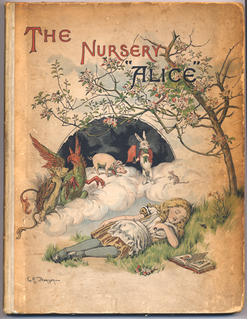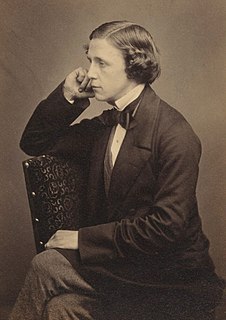
Alice's Adventures in Wonderland is an 1865 novel written by English author Charles Lutwidge Dodgson under the pseudonym Lewis Carroll. It tells of a young girl named Alice falling through a rabbit hole into a fantasy world populated by peculiar, anthropomorphic creatures. The tale plays with logic, giving the story lasting popularity with adults as well as with children. It is considered to be one of the best examples of the literary nonsense genre. Its narrative course, structure, characters, and imagery have been enormously influential in both popular culture and literature, especially in the fantasy genre.

Alice is a fictional character and protagonist of Lewis Carroll's children's novel Alice's Adventures in Wonderland (1865) and its sequel, Through the Looking-Glass (1871). A child in the mid-Victorian era, Alice unintentionally goes on an underground adventure after accidentally falling down a rabbit hole into Wonderland; in the sequel, she steps through a mirror into an alternative world.

The Cheshire Cat is a fictional cat popularised by Lewis Carroll in Alice's Adventures in Wonderland and known for its distinctive mischievous grin. While most often celebrated in Alice-related contexts, the Cheshire Cat predates the 1865 novel and has transcended the context of literature and become enmeshed in popular culture, appearing in various forms of media, from political cartoons to television, as well as cross-disciplinary studies, from business to science. One of its distinguishing features is that from time to time its body disappears, the last thing visible being its iconic grin.

The Nursery "Alice" (1889/90) is a shortened version of Alice's Adventures in Wonderland (1865) by Lewis Carroll, adapted by the author himself for children "from nought to five". It includes 20 of John Tenniel's illustrations from the original book, redrawn, enlarged, coloured – and, in some cases, revised – by Tenniel himself. The book was published by Macmillan a quarter-century after the original Alice. It featured new illustrated front and back covers in full colour by E. Gertrude Thomson, who was a good friend of Dodgson. The book was 'engraved and printed' by the famous colour printer Edmund Evans.

A New Alice in the Old Wonderland is a fantasy novel written by Anna M. Richards, illustrated by Anna M. Richards Jr., and published in 1895 by J. B. Lippincott of Philadelphia. According to Carolyn Sigler, it is one of the more important "Alice imitations", or novels inspired by Lewis Carroll's Alice books.
— From Lewis Carroll's "Jabberwocky", published as part of Through the Looking Glass

One of the most iconic figures to emerge from 19th century children's literature, and one who is instantly recognized by her attire, is Alice in Wonderland. Although many artists have depicted Alice in many different ways, the original illustrations by John Tenniel have become iconic through their subsequent repetition in most published editions and film adaptations. Accordingly, Alice's clothing was the subject of a 2019 monograph.
"All in the golden afternoon" is the prefatory poem in the book Alice's Adventures in Wonderland by Lewis Carroll. The book was first published in 1865 by London's Macmillan. The introductory poem recalls the afternoon on which he improvised the story about Alice in Wonderland on a boat trip from Oxford to Godstow, for the benefit of the three Liddell sisters, Lorina ("Prima"), Alice ("Secunda") and Edith ("Tertia"), with Alice being the one which inspired Carroll's main character.

The Wallypug of Why is an 1895 children's novel by G. E. Farrow. The book is an exercise in humorous nonsense, rich in wordplay and absurd situations, in the tradition of Lewis Carroll's Alice's Adventures in Wonderland. A popular success, it inaugurated a series of Wallypug sequels.

Charles Lutwidge Dodgson, better known by his pen name Lewis Carroll, was an English writer of world-famous children's fiction, notably Alice's Adventures in Wonderland and its sequel Through the Looking-Glass. He was noted for his facility at word play, logic, and fantasy. The poems Jabberwocky and The Hunting of the Snark are classified in the genre of literary nonsense. He was also a mathematician, photographer, and Anglican deacon.
Lewis Carroll’s Alice's Adventures in Wonderland has been translated into 174 languages. The language with the most editions of the Alice in Wonderland novels in translation is Japanese, with 1,271 editions. Some translations, with the first date of publishing and of reprints or re-editions by other publishers, are:
Lewis Carroll’s Through the Looking-Glass and What Alice Found There has been translated into 65 languages. Some of the translations, with the first date of publishing and of reprints or re-editions by other publishers, are:

Wonderland is the setting for Lewis Carroll's 1865 children's novel Alice's Adventures in Wonderland.

New Adventures of Alice is a novel by John Rae, written in 1917 and published by P. F. Volland of Chicago. It is, according to Carolyn Sigler, one of the more important "Alice imitations", or novels inspired by Lewis Carroll's Alice books.

Gladys in Grammarland is a novel by Audrey Mayhew Allen, written ca. 1897 and published by the Roxburghe Press of Westminster. It is an educational imitation of Lewis Carroll's book Alice's Adventures in Wonderland.

Davy and the Goblin, or, What Followed Reading "Alice's Adventures in Wonderland" is a novel by Charles E. Carryl that was serialized in St. Nicholas magazine from December 1884 to March 1885 before being published by Houghton Mifflin of Boston and Frederick Warne of London in 1885. It was one of the first "imitations" inspired by Lewis Carroll's two books, Alice's Adventures in Wonderland and Through the Looking-Glass.

The Admiral's Caravan is a novel by Charles E. Carryl, written in 1891 and published by the Century Company of New York in 1892. It is one of many literary "imitations" inspired by Lewis Carroll's two books, Alice's Adventures in Wonderland and Through the Looking-Glass. It appeared in serialized form in the children's periodical St Nicholas beginning in 1891.




















